Vernacular Visions - A folklife history of Australia
A fundamental requirement for any historian is to be able to see the world as it is and not how you would like it to be. Equally important is having sufficient confidence not to be beholden to modish schools of analysis and criticism. It is a great strength of this book that it encounters the world not with a rush to judgment but a quest for understanding.
READ REVIEW
↓
Vernacular Visions - A folklife history of Australia:
art, diversity, storytelling
Noris Ioannou | 2021
To begin at the beginning, let me say that the preliminary pages of this book – the preface, note to the reader and acknowledgements – all deserve close attention, as they lucidly outline the intellectual journey the author has taken to be in a position to create this very well written and cogently argued work.
In the opening paragraph of Chapter One, ‘The meaning of folk art, past and present’, it quickly becomes apparent that the author has thought deeply about his subject, is well aware of the limitations of prior approaches to the topic and is very clear about the contribution he seeks to make:
Folk artworks portray the way we see ourselves collectively as a nation. They act as social documents of Australia’s experience, depicting past and present ways of living, thinking and doing things. They celebrate our past, they tell stories, they divulge lifestyle, they proclaim beliefs and values, they exalt our religions, they comment on social injustice, they lampoon political individuals, and they commemorate special occasions. In short, the art of the peoples defines collective and individual identity. (p. 2)
He soon elaborates:
This book presents and argues for a wider meaning of folk art beyond its ‘traditional’ parameters than has been generally accepted. American scholarship has been especially instrumental in achieving this viewpoint, one that reveals the regenerative potential of traditional creativity and aesthetics in a modern world dominated by industry and mass culture.
Above all, this book emphasises the creative processes and uses of folk art, rather than simply looking at its production and existence as independent artefacts. Instead of being a differentiating term that allows the compilation of a particular category of artwork, ‘folk art’ is embraced as a means of investigation, as a tool that permits the re-seeing of everyday phenomena in the sphere of creativity. (p. 3)
The breadth of the book’s coverage is impressive, with chapters devoted to traditional Aboriginal art, pioneer and Australian-Germanic folk arts, the folk-art landscape, folk painters, working men’s traditions, textile arts, the bush tradition of making-do, what he calls outsider/insider visions and new age folk art.
Within these categories the author’s philosophical approach allows Lobethal’s Christmas Lights, the protest sculptures along the roadside near South Australia’s Dublin, and the ‘Big Things’ across the continent to receive equivalent attention to more conventional subjects like ‘naïve art’. Ioannou unpacks such a categorisation by focusing on the creative process:
Australian folk or naïve artists are the unofficial documenters of local histories – of ordinary people, specific places and the events that fill out the substance of everyday life. With few exceptions, the naïve, primitive or folk painter is self-taught, yet visualises, through an intensity of personal experience, a portrait of their life and place. Colourful, engaging, and habitually autobiographical, their works can be surprisingly insightful, disclosing Australia’s unique characters, their own stories and their connection to particular places. (p. 150)
This is a most impressive piece of scholarship, accompanied by illustrations whose number, quality and diversity do the book proud.
Reviewer: Brian Samuels, PHA (SA)
Note: The reviewer’s enthusiasm for this book may have been influenced by decades of folk music, singing and dancing (a living heritage seemingly overlooked by many historians), his significant collection of kitsch and a real stuffed sheep bought to celebrate Australia Day and named Baaa–sil by the delivery man.
Vernacular Visions - A folklife history of Australia: art, diversity, storytelling is published by Wakefield Press.

